
Volume 49 Number 2 | June 2024


Volume 49 Number 2 | June 2024

Te Kawe Ritenga Tapu to carry the sacred rituals
A quarterly magazine to support liturgical life in parishes, schools and faith communities.
Produced by the Catholic Diocese of Auckland
The Liturgy Centre - Te Kawe Ritenga Tapu
Mission Statement:
To resource and energize our faith communities to participate fully, consciously and actively in the liturgy and so take up Christ's Mission.

See back cover for subscription information. Visit our website at www.aucklandcatholic.org.nz/liturgy
On the front cover: Image: Architecture of St Joseph Catholic Church, Kaitaia Some contents of Liturgy are reserved to their respective owners and are used in this publication with permission.

From the Liturgy
Jubilee of Hope 2025 Hymn: Pilgrims of Hope (Lead/Guitar) 6 Let the Little Children Have their Own Liturgy of the Word 12 Is our Eucharist too Clericalized?
Self-Intinction
Hallmarks of Well Celebrated Parish Liturgy
22 Readings & Music Suggestons: July (14th - 17th Sunday in Ordinary Time) 28 Resources from the Liturgy Centre
Contributions are welcome: The Editor, Liturgy Centre, Catholic Diocese of Auckland.
Email: liturgycentre@cda.org.nz
Ph: (09) 360 3061
Postal address: Private Bag 47904, Ponsonby, Auckland, 1144, Aotearoa - New Zealand © Catholic Diocese of Auckland. All rights reserved. Registered Magazine ISSN 1170-4314
A few Sundays ago we heard about the parable of the mustard seed from the Gospel reading according to Mark. In many ways, the story about the planting of a seed and patiently waiting for it to grow, reveals to us the humbling mystery of how Jesus works in our lives. As people involved in planning and preparing the liturgy, this could not be more true.
For many, fulfilling the role of a liturgical minister either through proclaiming the Word, leading others in song, facilitating Children's Liturgy of the word, or as a sacristan behind-the-scenes - can often mean dettaching from one's self from the role, and allowing God to work in and through us, as vessels. Servants with a heart for service, called to sow seeds, and to allow Christ to work in each person as they grow. But are we seed sowers, or is Jesus sowing the seeds in us in order to serve others? Perhaps in reflection, we can come to find the answer to this, and serve our purpose in the Creator's mission of sowing mutard seeds.
In this issue of Liturgy, Anne explores the benefits of Children's Liturgy of the Word, and how we can nurture this hospitality to enable young people to be full participants in the liturgy. Only through participation can we grow in faith, as set out by Fr Peter in posing a question: is the Eucharist is too clericalised? He calls to reflection on how carefully we are following the rubrics set out by Sacrosanctum Concilium - a blueprint that guides our liturgical approach. There is also a revised diocesan guideline on the practice of self-intinction, as well as an article on the hallmarks of a well celebrated liturgy.
Please be advised that we have fully switched to DIGITAL publication. Subscription payments have been discontinued, and our entire magazine is now available for FREE.
If you have any queries, please contact us at: liturgycentre@cda.org.nz





Anne McGowan
“We must enable baptized children to participate in the liturgy more fully, without hindrance.”
Reprinted with permission by U.S. Catholic. U.S. Catholic is published by the Claretian Missionaries. Call 1-800-328-6515 for subscription information.
When my husband and I brought each of our babies for baptism, the church posed two questions: “What name do you give your child?” and “What do you ask of God’s church?” The standard answer to the second question in the Order of Baptism of Children is “baptism,” which also bestows on those children the new name of “Christian.” The vision of the Second Vatican Council grounded the liturgical identity and participation of Christians in the sacrament of baptism, declaring that full, conscious, and active participation is “demanded by the very nature of the liturgy,” is the “right and duty [of all the faithful] by reason of their baptism,” and is the “aim to be considered before all else” in guiding liturgical renewal.
As both of my children grew, they seemed to have an innate understanding of this in different ways. My eldest went through a phase as a toddler of signing himself at home with water from a basin just his
size—the toilet. My youngest was eager to touch what she dubbed the “Amen water” in the baptismal font at church. If all the baptized have the capacity for liturgy, even the littlest ones, Catholic parishes do children a disservice when they fail to welcome and accommodate the full liturgical engagement of children in developmentally appropriate ways.
Children’s Liturgy of the Word (CLOW) manifests the church’s hospitality toward children as Christian believers who are called, like everyone else, to grow in their faith through liturgical celebrations. CLOW derives ultimately from another insight of Vatican II: Liturgy must allow “legitimate variations and adaptations to different groups, regions, and peoples.”
The Directory for Masses with Children (DMC), issued by the Congregation for Divine Worship in 1973, provides guidance for Masses “with children who have not yet entered the period of preadolescence,” focusing especially on baptized children who have not yet
completed their sacramental initiation through confirmation and Eucharist and who may still be relatively new recipients of holy communion.
The DMC acknowledges special affinities and characteristics of young children that shape the ways they often prefer to engage liturgy—for example, through ritual repetition; through music, singing, and embodied sensory interactions; and with extra help settling into short periods of silence.
The DMC seeks to combat potential spiritual harm that may result when “children repeatedly experience in the Church things that are barely comprehensible” while at the same time it seeks to lead children toward the goal of full participation in the one liturgical assembly of the local church where
God is worshipped as Mystery beyond anyone’s understanding.
To that end, “Sometimes . . . if the place itself and the nature of the community permit, it will be appropriate to celebrate the Liturgy of the Word, including a homily, with the children in a separate, but not too distant, room,” with young children rejoining older children and adults for the liturgy of the Eucharist.
“Children’s Liturgy of the Word manifests the
church’s hospitality toward children as Christian believers who are called, like everyone else, to grow in their faith through liturgical celebrations…”
When implemented as intended, CLOW offers several benefits not just to children but to the entire parish.
CLOW highlights children as welcomed members of the liturgical assembly.

Seeing the joy and enthusiasm children display when given the opportunity to hear and respond to God’s word can be a powerful witness to adult assembly members that might help them be more tolerant of wiggles or interjections not made at church-whisper volume from these same children during other parts of Mass. The ritual rhythm of CLOW can also remind presiders to do what the DMC suggests even at parish Masses without CLOW—regularly acknowledge the presence and concerns of children in comments made at the beginning and end of Mass and during the homily.
CLOW forms children as missionary disciples who hear and respond to God’s word
CLOW provides children with a robust, age-appropriate experience of liturgy that parallels what is happening in the assembly they just left. Perhaps after a brief resettling activity like a song or prayer, children hear God’s word proclaimed in one or more readings from scripture (always including the gospel). These readings may come from the Lectionary for Masses with Children, which draws on a biblical translation that uses simple but not childish language. Children sing the responsorial psalm’s refrain and the gospel acclamation.
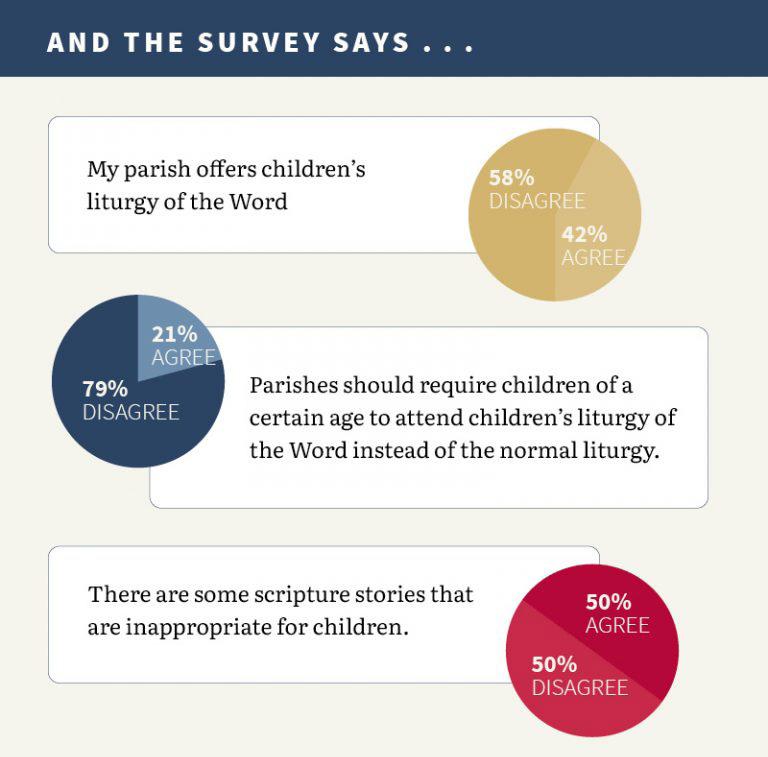
Someone preaches so that, having heard God’s word, the children might come to believe more fully (see Rom. 10:14) and begin to apply it to their lives. Children then profess their faith—the shared faith of the whole church— by reciting the Apostles’ Creed, responding to creedal questions, or repeating a sung refrain when prompted. Little liturgists learn to exercise their role as baptized members of the assembly by offering prayers for the church, the world, those in need, and the local community—likely including some special intentions dearest to their own hearts. The
children’s response to God’s word might incorporate some form of activity after discussing the scripture reading(s), but CLOW is not just catechesis featuring a Bible story, craft, and snack that gives children something to do and older Mass-goers some peace. The liturgy of the Word might be the most difficult of the four parts of the Mass for young children to participate in, with its long periods of received proclamation (readings and homily) punctuated by shorter opportunities for more active response (psalm, creed, and prayer of the faithful).
By helping younger children navigate the liturgy of the Word in an engaging way, CLOW prepares them to continue listening and responding to God’s word in liturgy and life as they grow in age, grace, and wisdom.
CLOW provides insight into good preaching practices
Sofia Cavalletti, a biblical scholar, and cofounder of the Catechesis of the Good Shepherd identified three “mysteries” that fascinate children from a young age: relationship, life and death, and time. Ann M. Garrido develops these themes as ideal foci for preaching with children in Mustard Seed Preaching (Liturgy Training Publications). However, since these mysteries remain equally relevant to adults, homilies that touch on these points likely will resonate with assembly members across the age spectrum, providing further opportunities to foster faith formation for all of God’s children.
“Any investment a parish makes in its children represents a commitment to the future of the church.”
In a rare instance of official permission for lay preaching even within Mass, the DMC envisions that non-ordained adults in certain circumstances occasionally might “speak to the children after the gospel, especially if the priest finds it difficult to adapt himself to the mentality of children.”
Any investment a parish makes in its children represents a commitment to the future of the church. Beginning CLOW requires only a supportive pastor, a small space to gather, and trained volunteers who love liturgy, scripture, and listening to what God reveals to little ones.
Enabling baptized children to participate in the liturgy more fully fulfils Jesus’ command to let children come to him without hindrance (Matt. 19:14). Puppets, parades, and paper crafts cannot substitute for—and might distract from—formative liturgical experiences that stimulate children’s imaginations and nurture their inclination to wonder and worship. Let us attend to what children will teach us about doing liturgy, listening to the word, and loving God. ■

As part of our Liturgical Ministries Series, the Liturgy Centre is offering a workshop day for leaders & facilitators of Liturgy of the Word with Children.
This session will be held on Saturday, 13th of July from 10am – 2pm, at Pompallier Diocesan Centre (30 New Street, St Mary’s Bay). Morning tea and lunch will be provided. The workshop will consist of foundations of ministry, safeguarding practices, and practical formation. Participants will receive a certificate at completion, which will be sent to their parish and presented at mass on a chosen date/time.
Register via the link below, by scanning the QR code (left poster) or by contacting your parish office/priest: www.aucklandcatholic.org.nz/liturgy-prayer/lowc-session
We have a resource page available for leaders & facilitators of Children's Liturgy of the Word. To access theses weekly Sunday resources, head on over to: www.aucklandcatholic.org.nz/liturgy-prayer (see Liturgy of the Word with Children webpage under 'Liturgy & Prayer')


Fr Peter Murphy is a retired priest of the Auckland Diocese, formerly Parish Priest of St Marys, Papakura, and Spiritual Director of Holy Cross Seminary.
One of the key features of the Vatican II Constitution on the Sacred Liturgy, Sacrosanctum Concilium, was the promotion of “fully conscious, and active participation in liturgical celebrations” (art. 14) on the part of the faithful. The understanding of this ‘active participation’ continues to evolve. It’s not a new principle. It goes back to earlier days of the liturgical renewal and specifically encouraged by Pope St Pius X. In the early days of the council reform it was identified with ‘doing’, such as the responses, the ministry of reading, the procession of the gifts and the like. This level of participation initially was a novelty and met the requirements. However, as time has gone on the limitations of this understanding has become more evident. The Sunday Eucharist is too busy. There is no time for quiet. This is aside from the quality of the reading, the homily and the singing.
The re-emergence of the popularity of the Tridentine Mass also leads us to ask the question: “What is missing in the new Mass that attracts people to the old?” My own belief is that much of this attraction hinges around the place of silence. Pope Francis, in Desiderio Desideravi,
Peter Murphy
following on from his predecessors, specifically emphasises the importance and necessity of silence. However, in my experience of Sunday liturgies, this is largely ignored. I often refer to a quote from the late Thomas Keating OCSO: “Silence is the language of God; everything else is a poor translation.” The call to contemplation is universal but only recently has this been encouraged among the faithful. Contemplation is empowering of the people. Fear of this is why the fruits of contemplation have been locked behind the walls of monasteries and enclosed convents.

Another aspect is the reliance upon the presiding priest to set the tone of the liturgical celebration, which connects with the frequent statements of Pope Francis on the insidious nature of clericalism. In my last parish where there were two priests, concelebration was standard practice during weekdays until one day an observant member of the parish – with a good liturgical sense – commented that this practice reinforced clericalism and the separation of the priests from the people. This was a light-bulb moment. From that time the practice ceased except for special occasions. Since then my usual practice when not presiding has been to participate in the Eucharist from the body of the church.
Concelebration was a compromise position for priests formed in the Tridentine Rite where the unwritten rule was that a priest said (sic) Mass every day. As such the concelebrating priest could still claim a stipend. But does this practice enforce a separation from the participating faithful? In the 60 years since Sacrosanctum Concilium there have been concerted attempts to pull back the reforms, that is until the present. Pope Francis has given unequivocal support to the liturgical reforms of Vatican II and even stepped in to block attempts by the previous head of the Congregation for the Liturgy, Cardinal Sarah, to further pull them back. One feature of the “pull back” was highlighting the distinction between clergy and the participating faithful.

My experience since “retirement” has been an opportunity to experience liturgy, both weekdays and Sundays, from “the other side”. I have noticed that the tone without doubt is set by the presiding priest. Is his heart in what he is doing or is he mechanical? There is an energy that emanates from him. Does he have a pastoral heart? Is he reaching out to those who are gathered there or is he locked into his own performance? What is the theology that he is communicating?
We are fortunate now that the leadership in the Church, and not just with liturgy, is coming from the top. However, the “pull back” from Vatican II has to some degree become entrenched particularly with two generations of priests having no direct experience of Vatican II. The result has been a looking back to a mythical past where there was certainty as against living with the uncertainty of the present. I
have noticed a highlighting of the words of institution with, in one instance the Body and Blood of Christ being held aloft for nearly half a minute, followed by the same priest “disappearing” behind the altar for an extended period of time. The whole of the Eucharistic prayer is consecratory.
The ignorance of liturgical theology among priests is disturbing. This can be seen in the redesign of churches with the replacement of the tabernacle above the altar. The placing of the tabernacle as a centre of devotion has been a difficulty in church redesign with many unsatisfactory placements, but going back is no answer. The placement of the tabernacle behind the altar is inexcusable in the design of new churches and clearly at odds with the General Instruction on the Roman Missal.
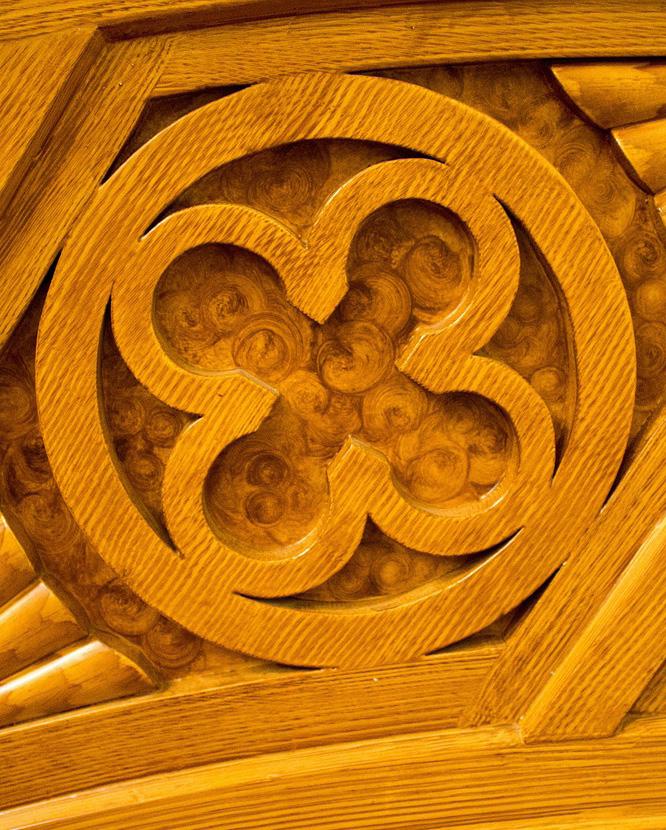
Another example is the automatic taking of consecrated breads from the tabernacle for distribution to the faithful. There are occasions where it may be necessary to have recourse to these but they are to be the exception, not the rule. There must be differentiation between the two as against mixing them which so often happens. The celebration of the Eucharist is not a Communion Service. The automatic recourse to the tabernacle makes it such. Ironically the instruction for the faithful to receive communion breads consecrated at that particular Mass goes back at least to Pope Pius X and even further. I suspect the re-emergence of this Jesus-in-the-tabernacle theology has much to do with the practice of adoration and the separation of adoration from the Eucharist instead of an extension of it.
The place of the priest as presider of the Eucharist is obvious and must not be reduced to saying the “magic words” of institution. Inclusiveness involves an openness in love to all who are gathered in worship. We do not want to return to the tyranny of rubrics which dominated the Tridentine Mass and which kills any sense of participation. Our scene is one that is evolving but must be based primarily on the principles as set down in Sacrosanctum Concilium. The question asked at the beginning, namely what can we draw from the “old Mass” in order to go forward, we need to keep asking. ■
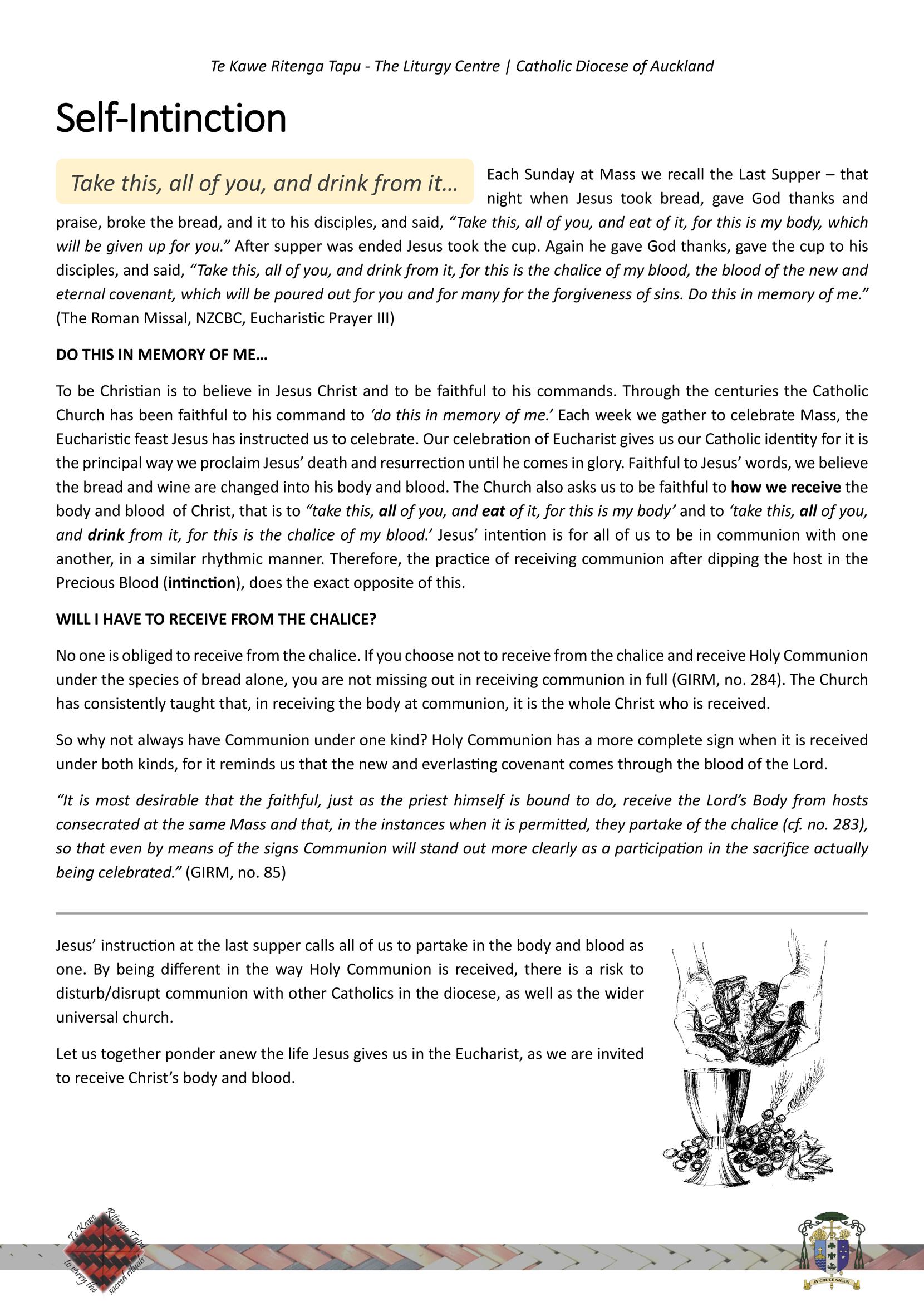

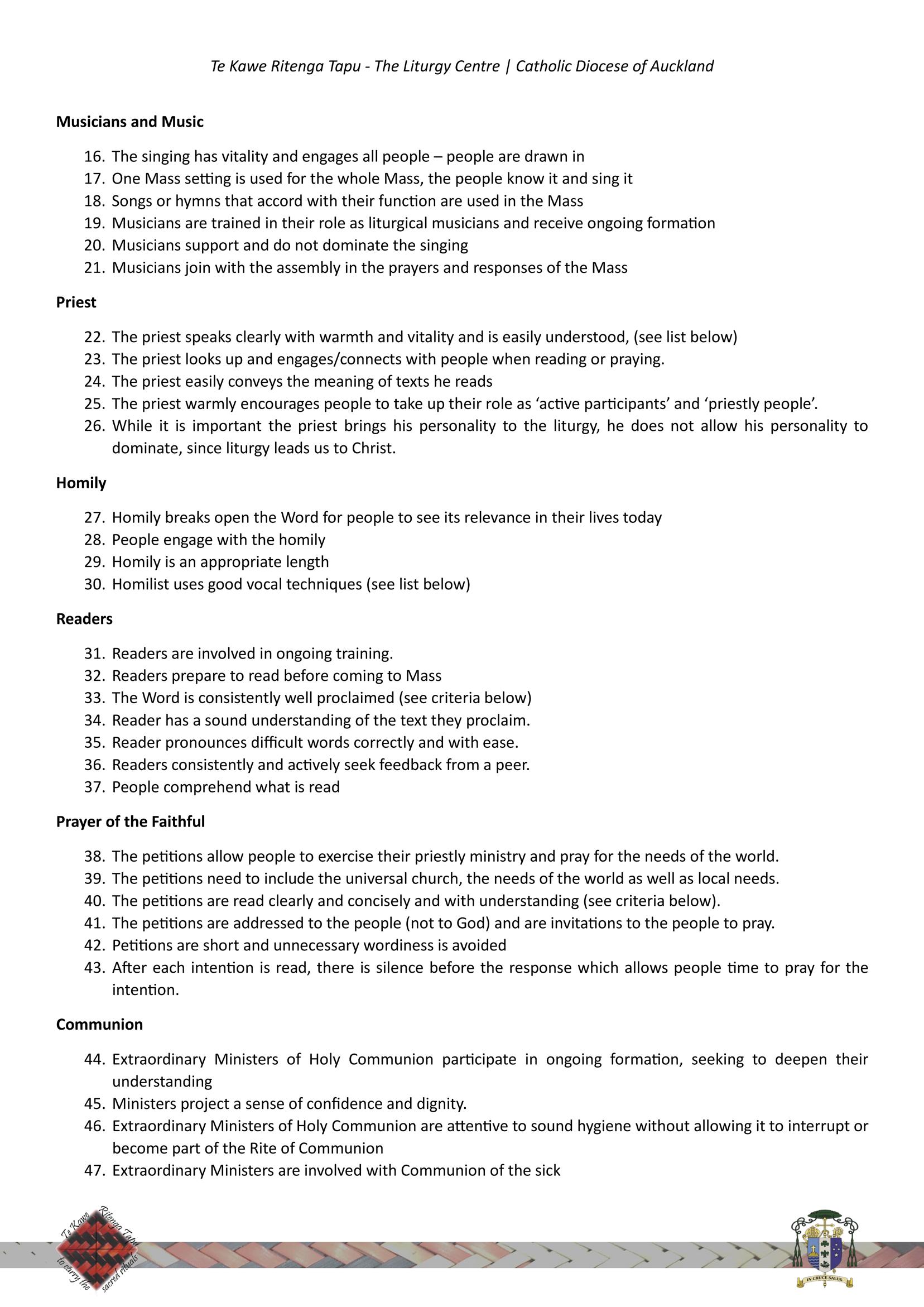
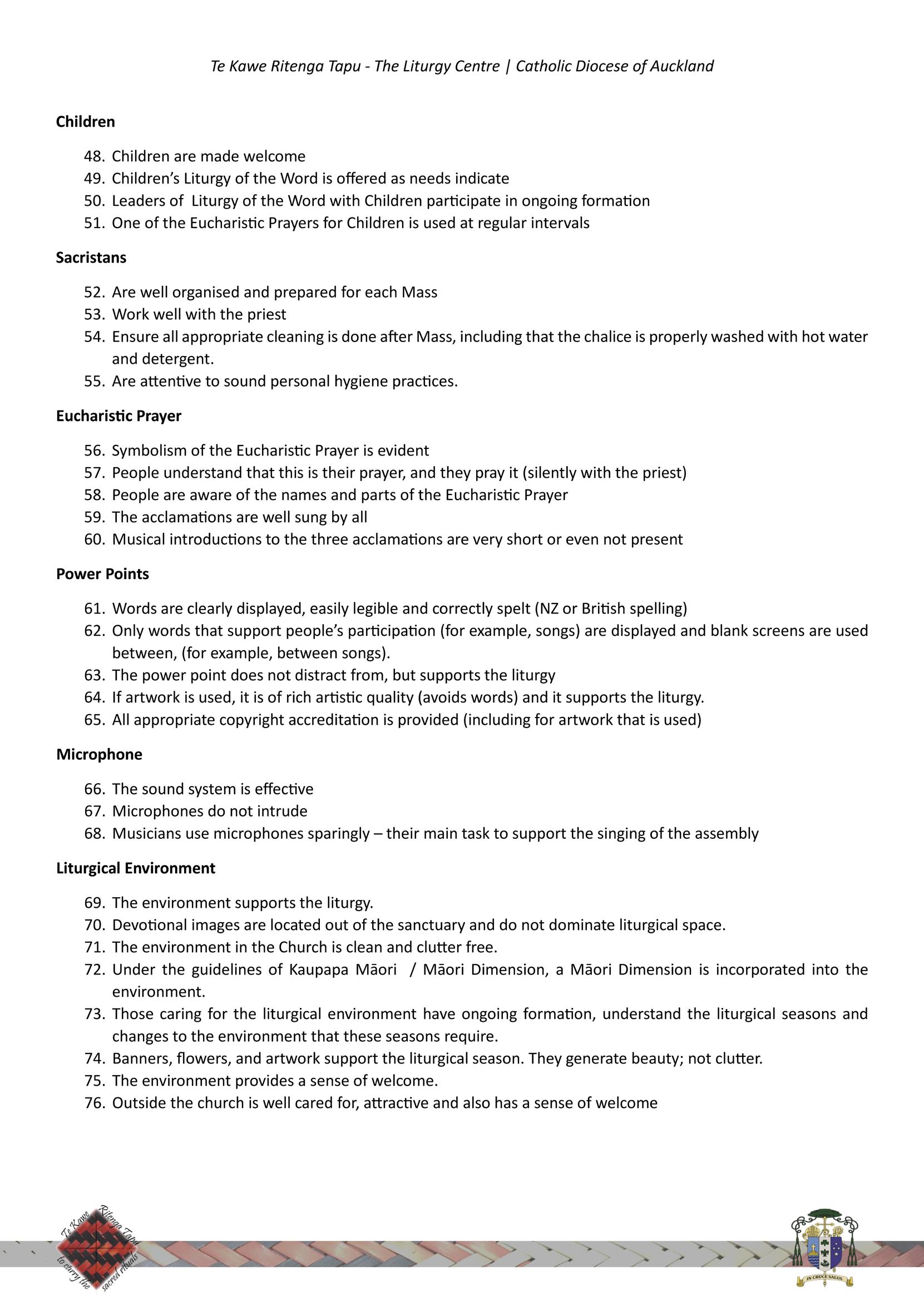
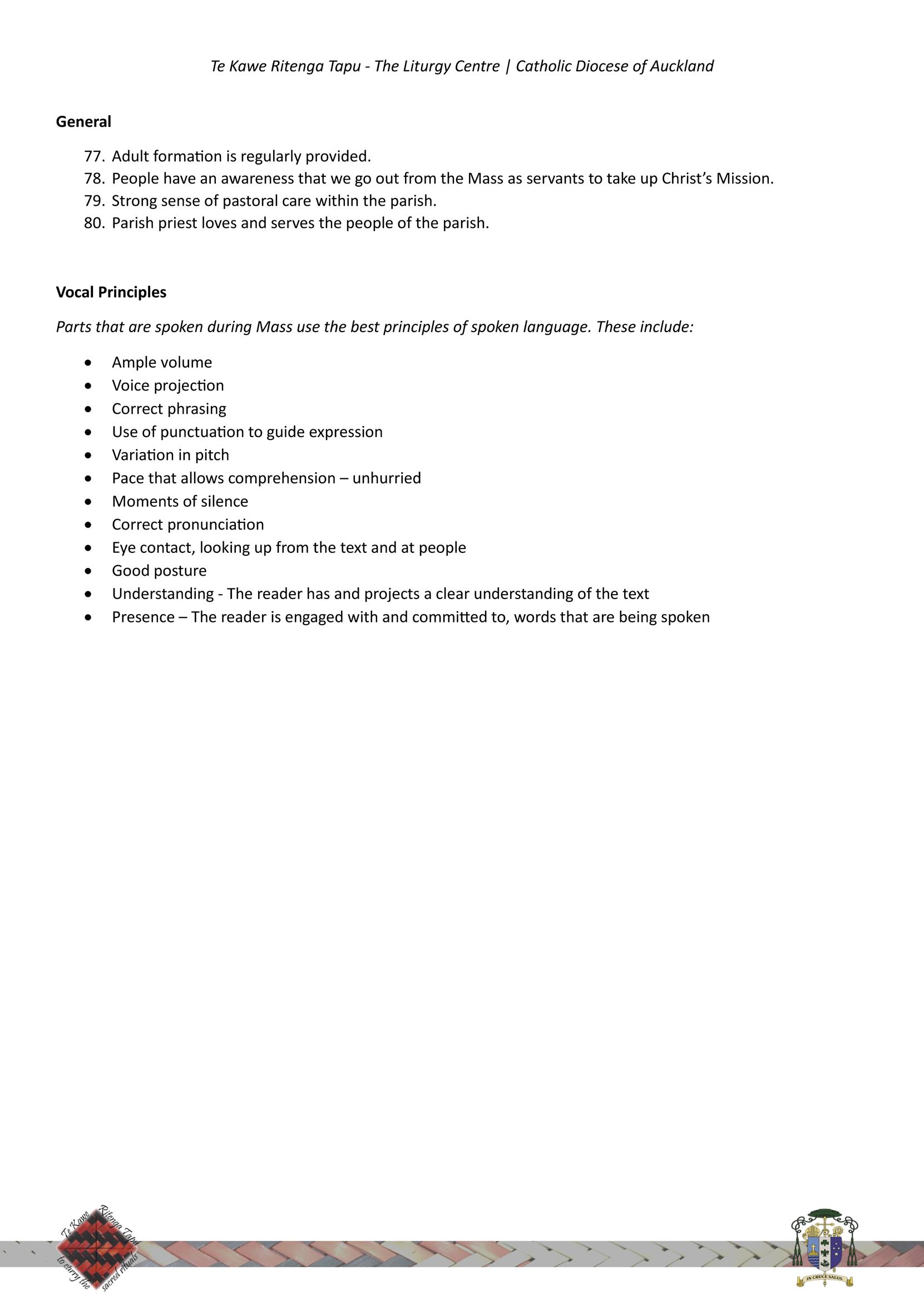

Richard S. Vosko
Book written by Richard S. Vosko. Collegeville, MN: Liturgical Press, 2019. Reviewed by Paul Turner, Pastor, Cathedral of the Immaculate Conception
First published in Worship, October 2022, Liturgy Press, reprinted with permission.
As large churches rise only upon solid foundations, so Richard Vosko builds the soaring theme of his book upon the bedrock of common ground. Readers of this journal who expect a book on architecture to focus on nuts and bolts, candles, eand chairs, will find their gaze shifting toward the heavens above and the earth below in order to view the full theological context into which a church building fits.
Vosko acknowledges the differences of social opinion that foil the formation of loving communities, but, as he sagely observes early on, “buildings stand because of the tensions between certain parts of the structure pushing against other pieces” (11). A building of contrasting forces can school people in the principles of harmony. He aims not just for common ground but for the common good. Any analysis of past trends in church architecture emphasises the distance between the divine and the

human, and indeed between clergy and lay. In an era when diversity unfolds in ever greater complexity, societies –and buildings – look for ways of lifting up what is common. With one eye on tradition, Vosko keeps another eye on innovation that can build on the success of the past to create spaces that engage the spirit of the present.
As the Second Vatican Council introduced a revolution in the liturgy of the Catholic Church, changes in architecture were bound to follow. The Constitution on the Sacred Liturgy considered little about this concern, but the implications of a full, conscious, active participation of the faithful soon demanded building in which worshipers could feel that they are indeed the priestly people gathered to offer sacrifice “not only by means of the hands of the Priest but also together with him” (GIRM 95).
To respond better to their elevated responsibilities, the faithful needed buildings offering them physical proximity to ritual action. Effective worship spaces achieve a symbiotic relationship between the sacred building and the sacred ritual (97).
In classical art, music, and architecture, the golden mean governed the achievement of beauty. Vosko finds additional criteria through nature’s use of rotundas. He invites worshipers to rethink the shape of sacred buildings. After all, believers may encounter God not only from above but also from within a gathered assembly.
Furthermore, sacred space serve and inspire the people. They aim to do more than gather communities for worship. They prepare people for their ministry outside the buildings as well. A sacred building lifts an individual into a personal spiritual realm, and it builds the sense of community during the time of worship; however, sacred space also sends the
same individuals back through the doors after worship and into the service of others.
At the conclusion of his book, Vosko analyses the architecture of megachurches. At first these seem distant from the long tradition of sacred spaces, yet they share certain themes: the construction of grand sacred spaces that accommodate a large number of people, where a designated area is set aside for those who lead the worship, and where leaders both invite participation in worship and expect social action when worshipers go forth into the world.
Vosko’s final pages will get readers thinking about sacred spaces in new and engaging ways, questioning how they perceive the realm where God resides, exploring how building engage the sorrows and joys of people, defending the diversity of architectural styles, affirming the contribution of contemporary artistry, and promoting the multiple uses of church in an age where ecological concerns lead to opportunities for believers of different kinds to share common ground.
Vosko’s book will engage all those planning a construction of new sacred space, the renovation of older churches, or a better understanding of how their sacred building either supports or challenges their own sense of God, community, and service. ■ See our Resource Catalogue to place an orderdetails on pg 28.
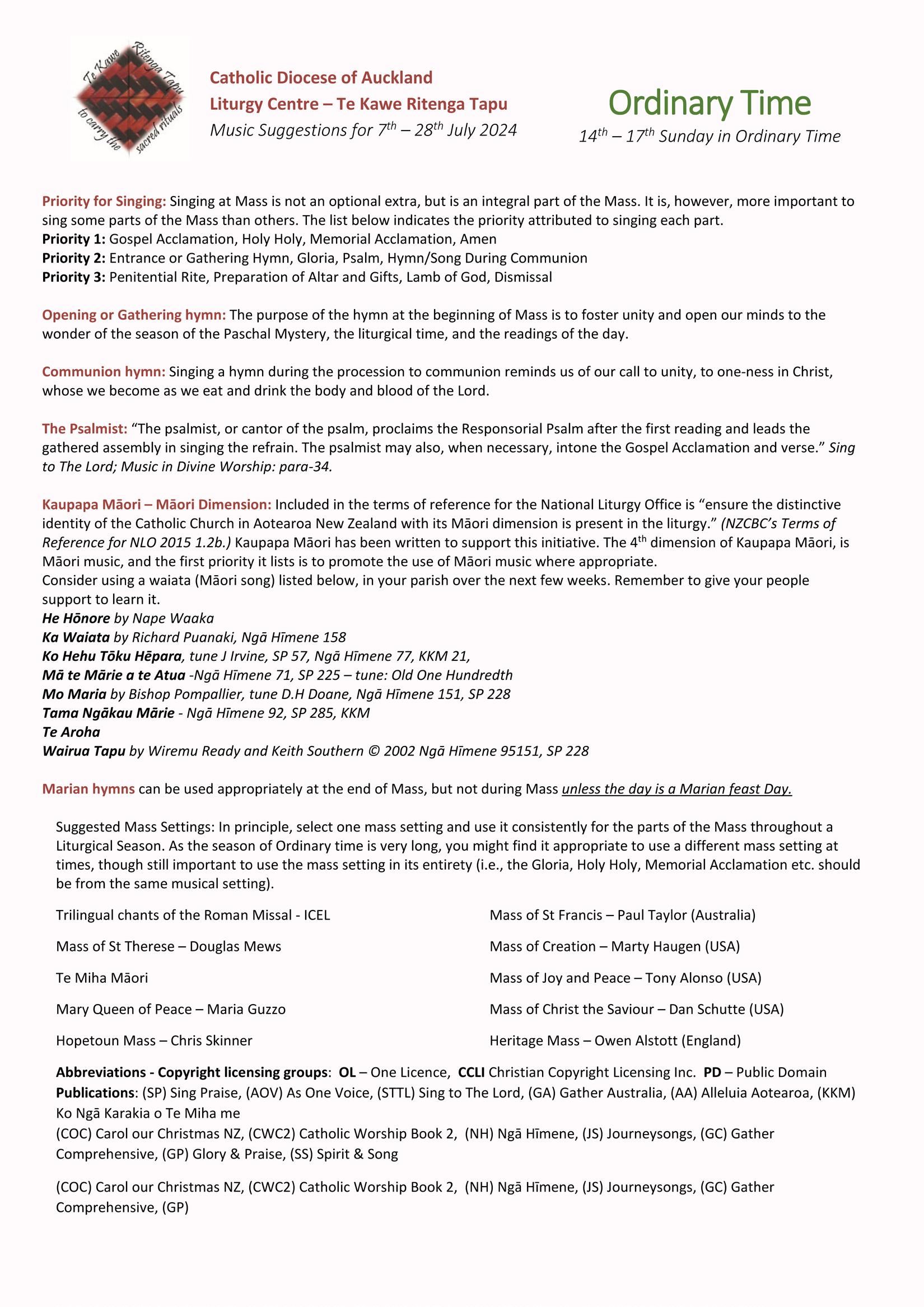





• Wednesday 31 July (pm) to Saturday 3 August (lunchtime)
• Residential (£465) | Non-Residential (£265)
• Liverpool Hope University
• Modern en-suite single accommodation
• Bursaries and day rates available
Sue Price | A Symphony of Praise: All Are Welcome?
Director of Pastoral Outreach, Margaret Beaufort Institute of Theology , Cambridge
David McLoughlin | The Worshipping Community at the Heart of Mission
Emeritus Fellow in Christian Theology, Newman University , Birmingham
Fleur Dorrell | Seeing Scripture Through Sounds and Colours
Biblical Apostolate Manager for the Bishops’ Conference of England and Wales in partnership with the Bible Society
Martin Foster | Introducing the Revised Lectionary
Director of the Liturgy Office, Bishops’ Conference of England and Wales



Director of Music
Christopher Walker
Internationally known lecturer , composer and choral conductor; formerly Director of Music at Clifton Cathedral
Director of Liturgy
Kathryn Turner
Freelance writer, workshop leader and member of the Bishops’ Conference Spirituality Committee
Fleur Dorrell | A Faith for all Seasons
Martin Foster | The Revised Lectionary
Fraser Macdonald | Raise Your Voice
David McLoughlin | The Didache and Mission
Adrian Porter sj | Psalms and the New Psalter
Sue Price | All Are Welcome
Kathryn Turner | An Unceasing Dialogue of Love
Christopher Walker | A Symphony of Praise

SSG Summer School c/o 7 Nore Farm Avenue
Emsworth



Hampshire PO10 7NA 07503 152 972 or 01243 374797
summerschool@ssg.org.uk ssg.org.uk
To see what's in store - use your smartphone to scan the QR code or visit: form.jotform.com/liturgycentre/resources



Guide for Liturgy Committees

Provide parish worship and liturgy committee members with the skills and theological insights that are vital to fulfilling their ministry with God’s grace and guidance.
Corinna Laughlin, Michael R. Prendergast, Joanne Sanders, Paul Turner | LTP
Guide for Ushers, Greeters, and Ministers of Hospitality
Equip your ushers and greeters with the knowledge, skills, and attitudes they can deploy to become effective and faith-filled ministers of hospitality.
Karie Ferrell, Corinna Laughlin, Paul Turner, Thomas P. Welch | LTP

Guide for Music Ministers
Music ministers offer their gift to the glory of God. Whether they sing or play, their ministry is essential to the worship of your parish. This third edition has been expanded to provide newly formed and experienced ministers alike with basic skills and theological insights in order to perform their ministry well.
Jennifer Kerr Budziak, Christopher J. Ferraro, Corinna Laughlin, Paul Turner | LTP




This newly revised and practical resource will assist in the training and theological and spiritual formation of extraordinary ministers of Holy Communion.
Corinna Laughlin, Kenneth A. Riley, Paul Turner | LTP
Provide your readers with the spiritual, liturgical, biblical, and technical training they need to proclaim God's Word effectively to the assembly.
Michael Cameron, Corinna Laughlin, Virginia Meagher, Paul Turner | LTP
Building on its original format, this second edition of Guide for Servers has been enhanced with new content and features that further develop both new and experienced servers with the skills and theological insights needed to perform their ministry well and in a Christ-like manner.
Corinna Laughlin, Paul Turner, D. Todd Williamson | LTP


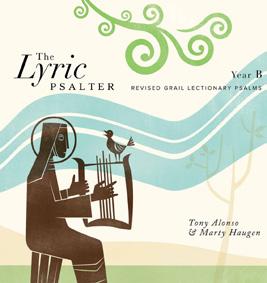

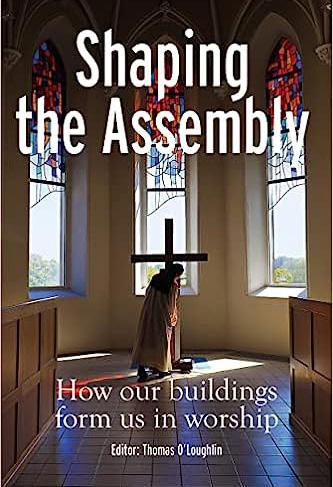

The Liturgy magazine is now available online and free of charge, as part of our committment to being eco-friendly and better accessibility.
All subscribers will receive a link to a digital copy, while some who have no access to online platforms will still receive a physical print.
To subscribe: Contact Liturgy Centre (+64) 09 360 3061
liturgycentre@cda.org.nz
We provide:
» Resources to support liturgical ministries, including books with Sunday & daily readings and reflections on the readings.
» Guidebooks for various ministries including sacristans, the preparation of liturgical environment, art, and architecture.
» Sheet music for choral ensembles & accompaniment.
» Formation opportunities for liturgical ministers.
» Website with Prayer of the Faithful, Liturgy of the Word with Children, Readings in Te Reo Māori, and Monthly Music Suggestions.
Workshop Formation for...
» Ministers of the Word
» Extraordinary Ministers of Holy Communion
» Liturgy Committee Members, Sacristans, Altar Server Trainers
» Leaders of Children's Liturgy of the Word
» A Walk through the Mass
» Lay Leaders of Liturgical Prayer
» Music Ministry: Building a Reportoire

» The Musician's Role (Choral Ensembles, Accompanists, Cantors)
» Managing ONE LICENSE Reporting & Copyright
Please contact the Liturgy Centre to discuss what formation you would like to provide for your liturgical ministers: liturgycentre@cda.org.nz